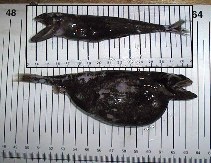http://www.fishbase.org/Summary/speciesSummary.php?genusname=Chiasmodon&speciesname=niger ---> http://192.134.151.83/Summary/speciesSummary.php?genusname=Chiasmodon&speciesname=niger
http://192.134.151.83/Summary/speciesSummary.php?genusname=Chiasmodon&speciesname=niger ---> https://fishbase.mnhn.fr/Summary/speciesSummary.php?genusname=Chiasmodon&speciesname=niger
https://fishbase.mnhn.fr/Summary/speciesSummary.php?genusname=Chiasmodon&speciesname=niger ---> https://fishbase.mnhn.fr/summary/Chiasmodon-niger.html
Chiasmodon niger, Black swallower

You can
sponsor
this page
Common name (e.g. trout)
Genus + Species (e.g. Gadus morhua)
-

-
About this page
-
Languages
-
User feedbacks
-
Citation
-
Uploads
-
Related species
-


 Black swallower
Add your observation in
Fish Watcher
Upload your
photos
and
videos
Black swallower
Add your observation in
Fish Watcher
Upload your
photos
and
videos
Pictures
|
Google image
 Chiasmodon niger
Chiasmodon niger
Picture by
Román Marcote, E.
Teleostei (teleosts) >
Scombriformes
(Mackerels) >
Chiasmodontidae
(Snaketooth fishes)
Etymology:
Chiasmodon:
Name from the Greek 'chiasmos' which means diagonally arranged, and 'odous' for tooth or teeth.
.
Environment: milieu / climate zone / depth range / distribution range
Ecology
Marine; pelagic-oceanic; depth range 700 - 2745 m (Ref.
58426
), usually 750 - ? m (Ref.
6649
). Deep-water; 46°N - 5°S, 95°W - 5°E (Ref.
82429
)
North Atlantic: tropical and temperate; including Gulf of Mexico, from 95°W to 5°E, 46°N to 5°S (Ref.
82429
). Southwestern Atlantic: Argentina (Ref.
44852
).
Size / Weight / Age
Maturity: L
m
?
range ? - ? cm
Max length : 25.0 cm SL male/unsexed; (Ref.
6944
)
Vertebrae
: 43 - 44. This species is distinguished from its congeners by a set of characteristics: from
C. braueri
by the teeth on second ceratobranchial absent (vs. present) and supraorbital canal pores 7 (vs. 8); from
C. harteli
by total vertebrae 43-45 (vs. 47-48), supraorbital canal pores 7 (vs. six); from
C. microcephalus
by teeth on basibranchials well developed, 3-18, always present on second basibranchial and often on third basibranchial and second hypobranchial (vs. usually no teeth on basibranchials, rarely 1-3, small, restricted to second basibranchial); from
C. pluriradiatus
and
C. asper
, by pectoral-fin rays 13-14 (vs. 15-16), tiny dermal spinules on body of specimens larger than 45.0 mm absent (vs. with spinules), fang in premaxillary head 1 (vs. 2), and supraorbital pores 7 (vs. 8 and 9, respectively) and from
C. pluriradiatus
by lateral-line pores 86-93 (vs. 91-94); from
C. subniger
, by teeth on second basibranchial present (vs. none), infraorbital pores 14 (vs. 12-13, modally 13), snout elongate and pointed, 22.2-26.6% HL (vs. snout short and blunt, 21.4-23.9% HL), upper jaw 72.2-80.0% HL (vs. 63.9-72.7% HL), and lower jaw 80.0-86.7% HL (vs. 69.0-76.7% HL) (Ref.
82429
).
Mesopelagic to bathypelagic species (Ref.
6944
,
28429
). Specimens larger than 4.5 cm are more frequently collected between 730 and 1900 m with shallowest record being 150 m, the deepest 3900 m (mean 1390 m). Juveniles are found in shallower water, from 0 to 1,050 m (mean 542 m), with the smallest specimens (>10.0 mm) collected nearest to the surface (Ref.
82429
). Feed on whole fish, often of individuals longer than themselves (Ref.
9686
). Most specimens were taken at depths greater than 750 m (Ref.
6649
).
Life cycle and mating behavior
Maturity
|
Reproduction
|
Spawning
|
Eggs
|
Fecundity
|
Larvae
Melo, M.R.S.
, 2009. Revision of the genus
Chiasmodon
(Acanthomorpha: Chiasmodontidae), with description of two new species. Copeia 2009(3):583-608. (Ref.
82429
)
IUCN Red List Status (Ref.
130435
)
Least Concern (LC)
; Date assessed:
15 July 2014
CITES
Not Evaluated
Not Evaluated
Threat to humans
Harmless
Human uses
Fisheries: of no interest
FAO - Publication:
search
|
FishSource
|
More information
Countries
FAO areas
Ecosystems
Occurrences
Introductions
Stocks
Ecology
Diet
Food items
Food consumption
Ration
Common names
Synonyms
Metabolism
Predators
Ecotoxicology
Reproduction
Maturity
Spawning
Spawning aggregation
Fecundity
Eggs
Egg development
Age/Size
Growth
Length-weight
Length-length
Length-frequencies
Morphometrics
Morphology
Larvae
Larval dynamics
Recruitment
Abundance
BRUVS
References
Aquaculture
Aquaculture profile
Strains
Genetics
Electrophoreses
Heritability
Diseases
Processing
Nutrients
Mass conversion
Collaborators
Pictures
Stamps, Coins Misc.
Sounds
Ciguatera
Speed
Swim. type
Gill area
Otoliths
Brains
Vision
Tools
E-book
|
Field guide
|
Length-frequency wizard
|
Life-history tool
|
Point map
|
Classification Tree
|
Catch-MSY
|
Special reports
Check for Aquarium maintenance
|
Check for Species Fact Sheets
|
Check for Aquaculture Fact Sheets
Download XML
Summary page
|
Point data
|
Common names
|
Photos
Internet sources
AFORO (otoliths)
|
Aquatic Commons
|
BHL
|
Cloffa
|
BOLDSystems
|
Websites from users
|
Check FishWatcher
|
CISTI
|
Catalog of Fishes
:
genus
,
species
|
DiscoverLife
|
ECOTOX
| FAO - Publication:
search
|
Faunafri
| Fishipedia |
Fishtrace
| GenBank:
genome
,
nucleotide
|
GloBI
|
Google Books
|
Google Scholar
|
Google
| IGFA World Record |
MitoFish
|
National databases
|
Otolith Atlas of Taiwan Fishes
|
PubMed
| Reef Life Survey | Socotra Atlas |
Tree of Life
| Wikipedia:
Go
,
Search
| World Records Freshwater Fishing |
Zoobank
|
Zoological Record
Estimates based on models
Preferred temperature (Ref.
123201
): 4.2 - 8.7, mean 4.9 °C (based on 355 cells).
Phylogenetic diversity index (Ref.
82804
): PD
50
= 0.5078 [Uniqueness, from 0.5 = low to 2.0 = high].
Bayesian length-weight: a=0.00389 (0.00180 - 0.00842), b=3.12 (2.94 - 3.30), in cm total length, based on all LWR estimates for this body shape (Ref.
93245
).
Trophic level (Ref.
69278
): 4.2 ±0.73 se; based on food items.
Fishing Vulnerability (Ref.
59153
): Low vulnerability (21 of 100).
Nutrients (Ref.
124155
): Calcium = 16.1 [5.5, 59.7] mg/100g; Iron = 0.607 [0.217, 1.659] mg/100g; Protein = 2.57 [0.00, 6.41] %; Omega3 = 0.382 [0.156, 0.978] g/100g; Selenium = 14.6 [4.3, 51.1] μg/100g; VitaminA = 15.3 [3.4, 71.6] μg/100g; Zinc = 0.383 [0.190, 0.761] mg/100g (wet weight);
Back to Search
Random Species
Back to Top
Accessed through:
Not available
FishBase mirror site :
localhost
Page last modified by :
mrius-barile
- 20 July 2016
Fatal error
: Uncaught ArgumentCountError: Too few arguments to function checkEcotox(), 1 passed in /var/www/html/summary/speciessummary.php on line 2304 and exactly 3 expected in /var/www/html/includes/speciessummary.lib.php:2579 Stack trace: #0 /var/www/html/summary/speciessummary.php(2304): checkEcotox() #1 {main} thrown in
/var/www/html/includes/speciessummary.lib.php
on line
2579
|